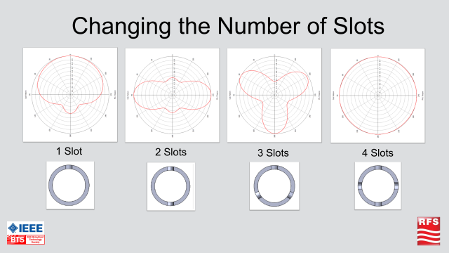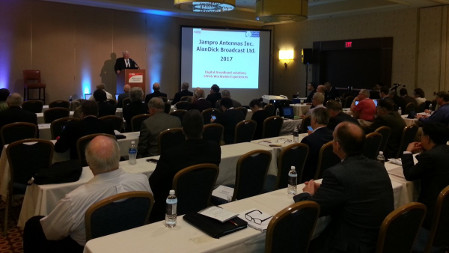IEEE Broadcast Symposium 2017 Part 2: Antennas
In my last column I discussed some of the papers presented at the 2017 IEEE Broadcast Symposium related to the FCC TV spectrum repack. This month I’ll look at presentations that covered broadcast TV antennas.
DESIGNING ANTENNAS
If you ever wondered how antenna patterns are created and why certain patterns seem to show up more often, the presentation “Antenna Design for the FCC Repack and Facility Maximization” by Nick Wymant, chief technology officer at Radio Frequency Systems’ Broadcast Division provided the answers. He also showed techniques for modifying antenna patterns to protect other stations when maximizing a station’s coverage.

Fig. 1: Typical patterns for slot antenna with 1, 2, 3 or 4 slots around
Wymant started by showing how the numbers of slots around a slot antenna’s pipe affect the azimuth pattern. Fig. 1 shows typical patterns for slot antenna with one, two, three or four slots around. Changing the diameter of the pipe will affect the shape of the pattern. For example, reducing the diameter of the pipe used for the three-slot pattern in Fig. 1 will reduce the depth of the nulls until it becomes a rounded triangle. Additional options for modifying the pattern include changing the amount of power going to the slot elements and adding wings or reflectors to the pipe to shape the pattern. The wide variety of patterns available with slots antennas is one of the reasons they are the most popular antenna type for high-power UHF broadcasting.
It is also possible to create custom patterns using panel antennas, which can be useful if they have to operate on more than one channel and support multiple stations. Panel antennas also offer the option of having different electrical or mechanical beam tilt at different azimuths. Wymant showed how panel antenna array patterns can be modified by changing the relative power and/or phase to each face, changing the array orientation and panel positions, or a combination of these methods.
Finding the right antenna pattern isn’t trivial. If options are limited to standard antenna patterns, a pattern that provides interference protection to a station in one direction will likely lead to reduced coverage in directions that don’t need protection. Wymant’s presentation showed the steps in optimizing antenna patterns to meet FCC replication requirements as well as maximizing coverage while still meeting interference protection requirements. The improved optimization method involves using the replication or interference-limited pattern template as a starting point instead of the end goal, and generating one or more customized patterns using powerful electromagnetic simulation software and evaluating to find the best pattern that meets coverage and FCC interference protection requirements. The paper is available to Symposium attendees and may also be available from RFS.
As a side note, I’ve developed software that uses the output of TVStudy to generate a template based on the minimum power reduction necessary on each radial to comply with FCC interference limits as well as maps showing the location and population of cells with interference. Anyone is free to download and use it. See my columns in IEEE Broadcast Technology (available in print and electronically to IEEE BTS members) or contact me for details if interested. Consulting engineer Merrill Weiss has also developed a program he uses—which was mentioned in Wymant’s presentation—that allows interactive modification of a pattern while viewing the amount of interference. This is useful, especially if the interference is present over a wide area, as it allows trading off more power reduction in one direction for greater power (and more interference) in a more desired direction.
WORLDWIDE EXAMPLES OF ANTENNA DESIGN & INSTALLATION
The presentation, “FCC DTV Repack, ATSC3-SFN Considerations & Worldwide Experiences – SFN” by Mark Fehlig and Ben Crease from Jampro Antennas and Alan Dick Broadcast Ltd. focused on the practical side of antenna selection and outlined some items to consider when designing antenna and transmission systems for ATSC 3.0 and single frequency networks. One of the slides shows DVB-T field strength planning requirements for different types of service. For portable outdoor reception, an outdoor field strength at UHF of 78 dBµV/m at 10 meters drops to only 61 dBµV/m at 1.8 meters. For portable indoor reception, an outdoor field strength of 88 dBµV/m at 10 meters will provide only 63 dBµV/m after reducing height to 1.8 meters and allowing for building penetration loss.

The presentation by Mark Fehlig and Ben Crease from Jampro Antennas and Alan Dick Broadcast Ltd. focused on the practical side of antenna selection.
The rest of the presentation shows some actual antenna installations and performance from around the world using broadband slot and panel antennas. The paper is available to Symposium attendees and should also be available from Jampro at the contacts listed on their web site.
AMT REPACK STRATEGY
Many TV stations being repacked have their antennas on towers owned by American Tower Corporation. If managing the repack is difficult for one station, imagine what it is like managing the repack of multiple stations on one tower. Jim Stenberg, principal engineer, RF Broadcast at American Tower Corporation (ATC), provided a glimpse of that in his presentation “Adventures in FCC repacking! Broadband Antenna Solutions.” Stenberg’s analysis showed that of the 987 Class A and Full Power licensees moving to new channels, 217 of them are on 133 ATC towers.
Stenberg said the FCC’s timeline faces challenges, notably the impact of weather on scheduling and construction delays by non-repack and FM stations. He also said broadcasters should not undervalue their spectrum, as “cord-cutting” is increasing in almost all markets. He was concerned about broadcasters’ lack of interest in interim alternatives while work is being completed and the minimal value placed on auxiliary facilities that could keep a station on the air.
The presentation used two ATC towers in Atlanta (Chester Avenue and Briarcliff 2) to illustrate ATC’s approach to the repack using broadband antennas. The goal was to minimize repack disruption by maintaining an optimal coverage contour during repack tower work while future-proofing RF systems to incorporate ATSC 3.0 capability into the design. Some key features include use of broadband antenna systems with dual feed lines and dual combiners capable of operating with different horizontal/vertical elliptical polarization ratios, azimuth patterns designed with low ripple and optimized beam tilt and null fill for the market.
I couldn’t quite follow all the moving pieces in the presentation and I’m sure as maximization applications are granted the pieces will move again. I know ATC is working with broadcasters to develop similar plans for other markets. If you weren’t at the Symposium, contact Jim Stenberg or one of other people in the broadcast division at ATC for a copy.
In my next column, I’ll wrap up my coverage of the IEEE Broadcast Symposium with a review of the papers on antenna pattern measurement with drones. With field measurements of signals a reimburable expense for stations replacing antennas as part of the repack, will stations opt for drone measurements rather than conventional ground measurement of signal strength? What are the tradeoffs? As always, your comments and questions are welcome. Email me at dlung@transmitter.com.
Get the TV Tech Newsletter
The professional video industry's #1 source for news, trends and product and tech information. Sign up below.

Doug Lung is one of America's foremost authorities on broadcast RF technology. As vice president of Broadcast Technology for NBCUniversal Local, H. Douglas Lung leads NBC and Telemundo-owned stations’ RF and transmission affairs, including microwave, radars, satellite uplinks, and FCC technical filings. Beginning his career in 1976 at KSCI in Los Angeles, Lung has nearly 50 years of experience in broadcast television engineering. Beginning in 1985, he led the engineering department for what was to become the Telemundo network and station group, assisting in the design, construction and installation of the company’s broadcast and cable facilities. Other projects include work on the launch of Hawaii’s first UHF TV station, the rollout and testing of the ATSC mobile-handheld standard, and software development related to the incentive auction TV spectrum repack. A longtime columnist for TV Technology, Doug is also a regular contributor to IEEE Broadcast Technology. He is the recipient of the 2023 NAB Television Engineering Award. He also received a Tech Leadership Award from TV Tech publisher Future plc in 2021 and is a member of the IEEE Broadcast Technology Society and the Society of Broadcast Engineers.
